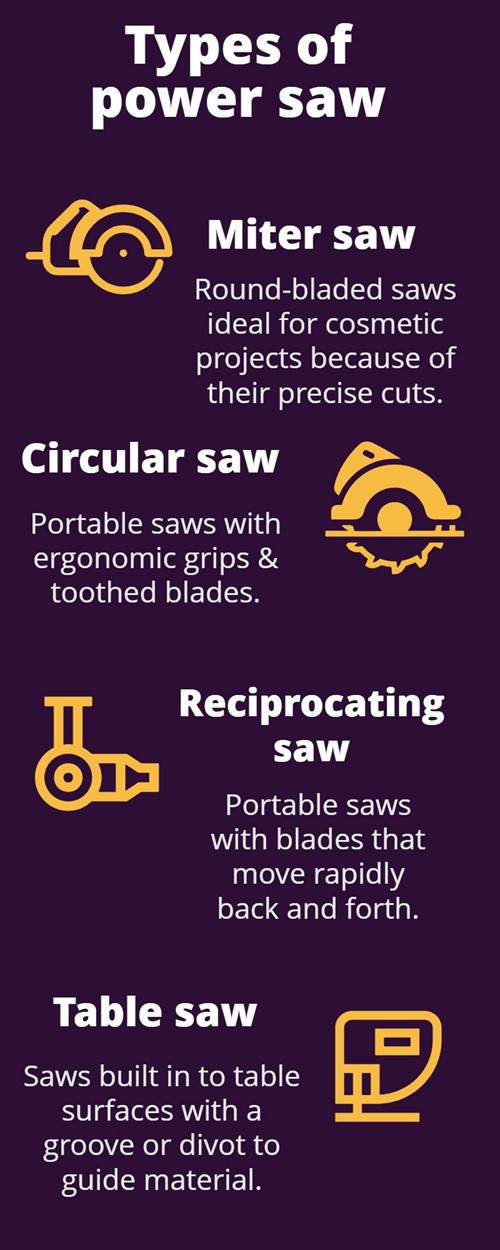
When it comes to cutting, saws are among the first tools many folks think of. Most think of a household hack saw or common rip-cut saw, both needing only a little elbow grease to cut through whatever medium you may be using. But what about power saws?
While hand saws are very common in the home, some power saws are equally common, though their primary use may be a little daunting at first.
Check out these four basic power saws and their primary function around the home:
Miter saws make home improvement projects, especially cosmetic ones, much easier thanks to the precision of their cuts. They're often characterized by having a circular blade attached to an arm that fits into the grooves outlined in the saw's base.
This allows homeowners and DIY enthusiasts more ease of use when creating miter joints, such as two pieces of crown molding cut to fit at a perfect 90-degree angle. Compound miter saws are also an excellent choice for individuals hoping to achieve perfect angled cuts, straight cuts and any combination of the two.
Circular saws tend to have a circular, toothed saw blade - often complete with saw guard - that are portable. These saws have grips in ergonomic and strategic places to ensure the user can safely cut through whatever surface they need to. However, because they are not stationary and don't have a base of their own, like miter saws, they often need a sawhorse or saw bench.
Unlike circular saws, reciprocating saws are straight blades that move back and forth, much like a rip-cut saw. These saws are portable and have a plug-stable power supply or are battery operated. They're fully portable and are exceptional for cutting piping, small pieces of wood, drywall and other small or harder to reach items and areas.
Unlike their counterparts, table saws are usually stationary. They often have a saw in the center of the table, with a divot that allows the saw to safely operate and slice through wood, soft metal, piping and other durable materials.
These vary in size and should be used in an area with plenty of room to avoid injury or inhalation of sawdust. They may also come in a variety of materials such as heft composite table surfaces, metal or other industrial materials.
These are just a few of the most dominant and common saws many homeowners and DIYers may find in their repertoire. If you're just starting out, these basics are excellent ways to determine which type of saws you may need for your projects, their defining characteristics and when you may use them.

If you're ever in doubt over how to use a certain type of saw or are simply uncomfortable using one, find a professional contractor to help out with any projects you may be engaging in. They'll have a wealth of knowledge and the expertise to help you successfully complete your home improvement goals.

Judy Gibbons is a highly accomplished Realtor licensed in Illinois, Michigan, and Florida. With an impressive list of accolades and a wealth of experience, she has become a prominent figure in the Chicagoland real estate industry. Gibbons is also an American Dream TV host, showcasing local businesses and beautiful properties.
As a global real estate advisor, Judy is known for her ability to seamlessly connect extraordinary homes with extraordinary lives. She possesses an extensive knowledge of the market, and is committed to providing world-class service to her clients. Gibbons can assist you whether it is with luxury real estate transactions, investment properties, short term rentals, or helping first time buyer clients with tall heir real estate needs.
With over 20+ years of experience, give Judy a call today and discover the difference of working with a real estate advisor who is dedicated to helping you achieve your real estate dreams, wherever they may lead you.
Designations/Licenses: Certified Distressed Property Expert, Broker, GREEN
Town Coverage: Chicago, Illinois, Arlington Heights, Illinois, Barrington, Illinois, North Barrington, Illinois